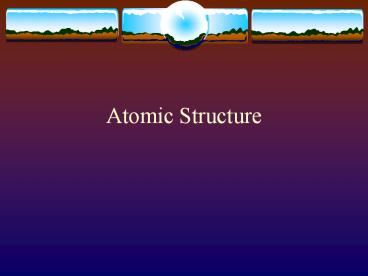Atomic Structure - PowerPoint PPT Presentation
Title:
Atomic Structure
Description:
Times New Roman Arial Wingdings Calibri Mountain 1_Mountain Atomic Structure History Planetary model The Shell Model The atoms makeup Mass of Subatomic Particles ... – PowerPoint PPT presentation
Number of Views:1158
Avg rating:3.0/5.0
Title: Atomic Structure
1
Atomic Structure
2
History
- 400 B.C. Democritus proposed all matter was
made up of small particles called atoms - Atomic numbers were assigned to elements by Henry
Moseley - 1913- Niels Bohr described the planetary model of
the atom
3
Planetary model
4
The Shell Model
- The more accurate model puts a cloud around the
nucleus and electrons move about in shells - Each shell can hold so many electrons
- Little energy in the most inner shell so only 2
electrons can be found there. - The farther you get from the nucleus, the more
electrons a shell can hold
5
The atoms makeup
- This shell model of a hydrogen atom or lead atom
is made up of the same general parts. - A nucleus made up of protons (1 in Hydrogen and
82 in Lead) and neutrons (usually the same amount
as the protons) - Floating around the nucleus are electrons
6
Mass of Subatomic Particles
- Particle Charge Mass compared Actual Mass
- to electron
- Electron Negative 1 9.11x10-31
- Proton Positive 1836 1.673x10-27
- Neutron Neutral 1841 1.675x10-27
7
Charges
- The three subatomic particles as they are called
have different charges - Protons- ()
- Neutrons- no charge
- Electrons- (-)
8
9
(No Transcript)
10
Atomic Mass
- The mass of an atom is equal to the number of
protons and neutrons found in the nucleus - If an atom of carbon has 6 protons and 6
neutrons, its mass is 12
11
Atomic Number
- The atomic number found above the chemical symbol
is equal to the number of protons the atom has - An atom with 19 protons has to be potassium (K)
12
Chemical Names
- Why is Co different from CO?
- Co is Cobalt
- CO is carbon monoxide
- Be sure to use upper and lower case properly
13
Isotopes
- Atoms of the same element that have different
numbers of neutrons are called isotopes - Hydrogen can have 0, 1, or 2 neutrons in its
nucleus
14
Misc. Facts
- Hydrogen is the most abundant element. It makes
up almost 90 of all atoms. As well it was the
1st element to exist - Fused hydrogen atoms formed inside stars and this
created the other elements - Most atoms formed when the universe began and are
constantly being recycled - Atoms that make up you are billions of years old
15
16
Chapter Review (class work)
- Try to complete 5, 6, and 7.
17
Protons have a positive charge
- True
- False
18
C-12 is a radioactive isotope used in carbon
dating fossils
- True
- False
19
The charge of a neutron is
- negative
- No charge
20
The number of electrons that can fit in the 1st
shell is
- 8
- 2
- 18
21
The electron has more mass than the proton and
neutron
- Yes
- No
22
The atomic number of carbon is
- 12.01115
- 12
- 6
- C
23
The element symbol of helium is
- H
- 2
- He
- Helium
24
The mass number of C-14 is 14
- True
- False
25
Play-doh Lab
- Partner up
- Create a 3 dimensional model of an atom using
play-doh and beads. It must be the shell model - Your atom must have an atomic number between 6
and 12. - On a separate sheet draw your atom and label the
following Protons, neutrons, electrons, nucleus,
electron cloud, any and all shells - Write down the name, atomic number, atomic mass,
and symbol































